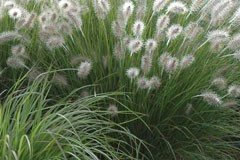
Campanula muralis
Dome-forming clumper for the rockgarden or border, flowering profusely during summer with mounds of purple bells. Non-invasive and generally tidy when not in flower. Dislikes acid soil.


Decorative grass with fluffy 'cats tail' seed heads. Does not seed in our summer dry temperate climates, but can be a strong seeder in warmer humid climates if seed heads not trimmed before dispersal.
Decorative grass with fluffy 'cats tail' seed heads. Does not seed in our summer dry temperate climates, but can be a strong seeder in warmer humid climates if seed heads not trimmed before dispersal.
Data sheet
Dome-forming clumper for the rockgarden or border, flowering profusely during summer with mounds of purple bells. Non-invasive and generally tidy when not in flower. Dislikes acid soil.
Shade loving variety with delicate soft pink flowers in summer. Use as background planting to hostas and hellebores for summer display.
A pretty, low growing rivale type, suitable for the the cottage garden, foreground beds or path edging. Long flowering, best in heavier fertile soils.
Delightful soft pink variety with single flowers for semi shade. A spreading plant useful for mass planting and ground cover beneath deciduous trees.
Rich pink variety, easy cottage garden plant flowering in autumn. Combine with ornamental grasses and sedums.
Semi double deep crimson red, a large flower with good colour. Grey foliage.
The deep orange pokers appear in mid summer with gaillardias, heleniums and rudbeckias. A shorter manageable variety that forms an evergreen mound of foliage. Easy to grow on most soil types.
Rich purple flowered variety, more mildew resistant than others in our area. Tall and self supporting non staking variety, useful as a cut flower.
Evergreen Iris from Burma, China and Japan. An attractive species with fans of leaves and light blue flowers in early summer. I find the foliage effect of this plant very useful when combined with grasses, sedums and euphorbias. Interesting large seed heads.
Upright grass colouring well in autumn. Favoured by contemporary designers for winter colour and structure.
White hydrangea, rounded clusters, vigorous and long flowering, colour not effected by soil pH.
Pink form of Veronica longifolia, a good perennial groundcover under roses and amongst other perennials.
Single, white flowered variety, shrubby in form, large flowers and strong growth habit. Clips nicely to form a mound of foliage or low hedge.
A useful pond side plant or for wet soils, where it will form a dense ground cover. Bright green leaves and red flowers during summer.
Old fashioned shade-loving primrose with burgundy gold edged flowers. Choice and lovely.
White double flowers. Strongly clumping variety useful as a cut flower or cottage garden background infill perennial; easy and prolific. Stake in windy areas or cram in between miscanthus and eupatorium.

Decorative grass with fluffy 'cats tail' seed heads. Does not seed in our summer dry temperate climates, but can be a strong seeder in warmer humid climates if seed heads not trimmed before dispersal.